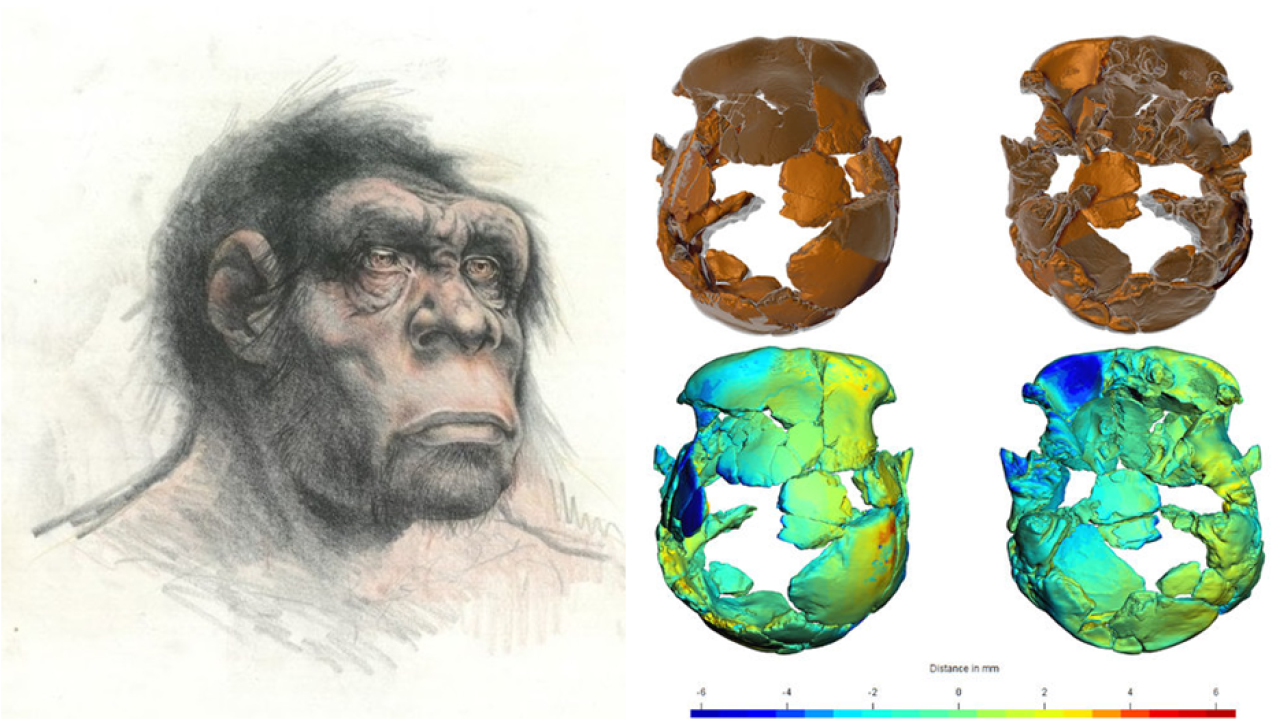
It was March 1994. During the construction works of a road near Ceprano (southern Lazio, Italy) the paleontologist Italo Bidittu was attentively looking for fossils in the area excavated by bulldozers, when he noticed the remains of a skull with clear archaic features and several bone fragments emerging from the soil.
It was the discovery of a lifetime: the ‘Ceprano calvarium’ is the oldest fossil skull discovered in Italy to date. Since its finding, paleoanthropologists have attempted three different reconstructions, combining various bone fragments with plaster parts, in efforts to determine the age of the skull. The dating process, however, has been quite challenging. The morphological structure of the sample seemed to suggest an approximate age of 800.000 years. The geological sediments where the fossil was found, though, were 'only' 400.000 years old. According to some scholars, a possible explanation could be that the skull ended up in those sediments thousands of years after the death of the man, as a consequence of sedimentary processes. But other hypotheses were also considered and researchers struggled to find an agreement.
 |
 |
| Credits: La Repubblica Photo | |
Now a team of researchers, including ICTP scientists Federico Bernardini and Claudio Tuniz, has provided new evidence supporting the hypothesis of the skull being ‘only’ 400.000 year old. The work has been featured in Scientific Reports.
Scientists used a high resolution micro-tomography technique to scan the sample over 360 degrees. After having virtually separate each fragment embedded in the cast matrix, researchers reassembled them in a digital 3D model. In doing so, they managed to virtually add most of the fragments left out by previous reconstructions. “The Ceprano calvarium was one of the first important samples we had the chance to measure in our laboratory here at ICTP, back in 2011,” says Bernardini, amongst the authors of the paper. “The instrument we used to perform X-ray micro-tomography was built in 2010, in the frame of a project funded by the Regione Friuli-Venezia Giulia in collaboration with Elettra Sincrotrone Trieste. It is now the only micro-CT facility in Italy dedicated to archaeology, paleoanthropology and cultural heritage.”
Thanks to this technique, the paleoanthropologists could perform a computer-assisted retrodeformation of the skull, deformed by the pressure of the soil burying it for centuries, thus reappraising past restorations and providing a revised interpretation of its original shape.
 |
 |
|
Credits: Di Vincenzo et al. Scientific Reports (2017)
|
“To recreate the morphological 3D model of the fossil was only the first step,” continues Bernardini, adding, “We needed to extract useful information from the data.” Through a process called segmentation, researchers discriminate different components of a sample according to their density: for the ‘Man of Ceprano’, the process proved to be particularly challenging, as the over 50 bone fragments showed a very similar density and there were two types of cast from previous restorations that needed to be manually separated. It required over two months of work to be completed.
The new insights provided by this work suggest that the 'Man of Ceprano' died where Italo Bidittu found him, and his specimen belongs to an archaic variant of Homo Heidelbergensis, the last common ancestor of both Homo Neanderthalensis and Homo Sapiens.
The apparent contradiction between the archaic characteristics characterizing the skull and its supposed relatively 'young’ age of 400.000 years has been explained by Giorgio Manzi, leader of the team of paleontologists from the University of Rome La Sapienza: “Hundreds of thousands of years ago the region where the Ceprano calvarium was found used to be very isolated. Its inhabitants hardly came into contact with nearby populations. A consequence of this could be that there may have been some archaic traits of human beings while more modern species were beginning to spread in the rest of Europe.”
 |
| Federico Bernardini in the Multidisciplinary Lab at ICTP |
Now, scientists are already tackling other questions. “The micro-CT data will allow us to reconstruct with great precision its external brain structure. Even though the brain is long gone, we are still able to obtain a perfect and highly detailed virtual endocranium onto which a mould of the cerebral cortex is imprinted.” says paper co-author Tuniz. Bernardini concludes, "The Ceprano calvarium is one of the most precious paleoanthropological remains found in Europe, representing a key step in the past evolution of the genus Homo to which we belong.”
---- Anna Lombardi
















